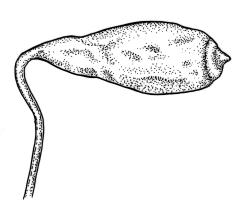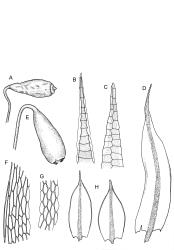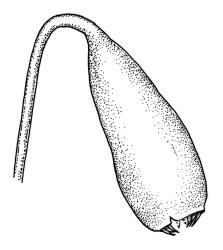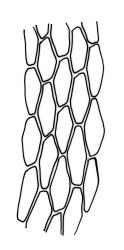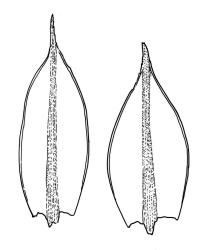Plants small and catkin-like, ± golden above, pink-green below. Stems red, to c. 7 mm, branching by subperichaetial innovation, densely beset below by brown, very finely papillose rhizoids, in cross-section with an indistinct central strand. Leaves ± crowded and larger at stem apices (moderately comose), erect when moist, scarcely altered when dry, elliptic-lanceolate, tapered to a narrowly acuminate apex, (1.5–)2–2.3 × 0.8–1 mm in coma (smaller on innovative branches, c. 1–1.3 mm) and with lamina c. 0.6–0.8 the total leaf length, pale green above and red below, serrulate in acumen, nearly entire below, moderately bordered, plane or weakly recurved at margins, not decurrent; upper laminal cells rhombic-hexagonal, thin- to firm-walled, mostly 54–65(–75) µm long and c. 2.5–3.5:1, not altered near apex, becoming more oblong towards base; marginal cells linear and firmer-walled to form a border c. 2–4 cells wide at mid leaf and extending to apex; basal cells pigmented in 1–2 rows but not otherwise differentiated. Costa long-excurrent. Gemmae sparsely present in axils of upper leaves, ± ellipsoid, with numerous primordial leaves occupying their full body length; tubers not seen.
Synoicous. Perichaetia single and near plant base or sometimes >1 per plant. Setae (6–)12–15 mm, red-brown, cygneous just below capsule; capsules pendent, pyriform, c. 2 × 1 mm, with a narrow mouth and a well-defined neck c. ⅓ the total length; operculum mammillate from a low conic base. Exostome teeth pale brown, c. 250–300 µm, narrowly lanceolate, bordered, with c. 12–14 adaxial lamellae; endostome ± adherent to the exostome, with segments nearly the height of the teeth and perforate, and cilia rudimentary. Spores 21–27 µm.
The most striking feature of the B. tenuidens peristome is the relatively short, lanceolate exostome teeth with few (c. 12–14) adaxial lamellae. The difficulty of observing both the exostomal lamellae and endostomal features is compounded by endostome adherence to the teeth. Some endostomal features appear to vary, even within a single capsule. Single, non-nodose cilia c. half the height of the teeth were observed, as were very rudimentary cilia scarcely projecting from the basal membrane. No nodose or appendiculate cilia were seen. Sainsbury (1945) made very similar observations.
In some respects, the type of B. tenuidens resembles a diminutive Bryum amblyodon. However, in addition to being smaller in virtually all respects (stem, leaf, seta, and capsule dimensions), the lack of leaf decurrencies, the tendency for the endostome to adhere to the exostome teeth, and fewer exostome tooth lamellae preclude placing B. tenuidens in synonymy with that species. The short, pyriform capsules are suggestive of some Pohlia spp., e.g. P. wahlenbergii. However, the presence of a well-developed leaf border prevents confusion with Pohlia.
SI: Nelson (Mt Arthur), Canterbury (Porters Pass).
Endemic.
The type specimen was collected at 1220 m on Mt Arthur (a marble massif), while the Porters Pass collection was from c. 610 m.
The species is retained here due to the distinctive features of its peristome, the pyriform capsule with a narrowed mouth, large spores, and catkin-like gametophytes.
Material in the Dixon herbarium is considered the holotype, despite the fact that material in herb. Sainsbury is more ample. The material in herb. Sainsbury (WELT M005687) is labelled as "Bryum tenuidens Dix." in Sainsbury's hand, thus making clear his reliance on Dixon's opinion concerning the status of this material. The protologue makes comparison to Bryum crateris Dixon and B. imperfectum Cardot, from Antarctica and southern South America, respectively. Ochyra et al. (2008, p. 482) treated both B. crateris Dixon and B. imperfectum Cardot as synonyms of B. archangelicum Bruch & Schimp. No material of these species has been available for comparison.
Bryum tenuidens was reported from the Waipakihi ("Waipakaki") River, Wellington L.D. by Bartlett (1985), based on a sparse collection (WELT M008374). While similar in overall habit, stature, capsule form, sexuality, and spore dimensions to the type of Bryum tenuidens, Bartlett's collection differs in significant ways, including exostome teeth with c. 20 lamellae, paired, appendiculate cilia, firmer-walled laminal cells, and considerably longer (to c. 25 mm) setae. Bartlett's record is not accepted here, but the specimen is too poor to permit confident determination.
Ochi (1970) provisionally recognised this species but subsequently (Ochi 1992) considered Bryum tenuidens an "uncertain species."



